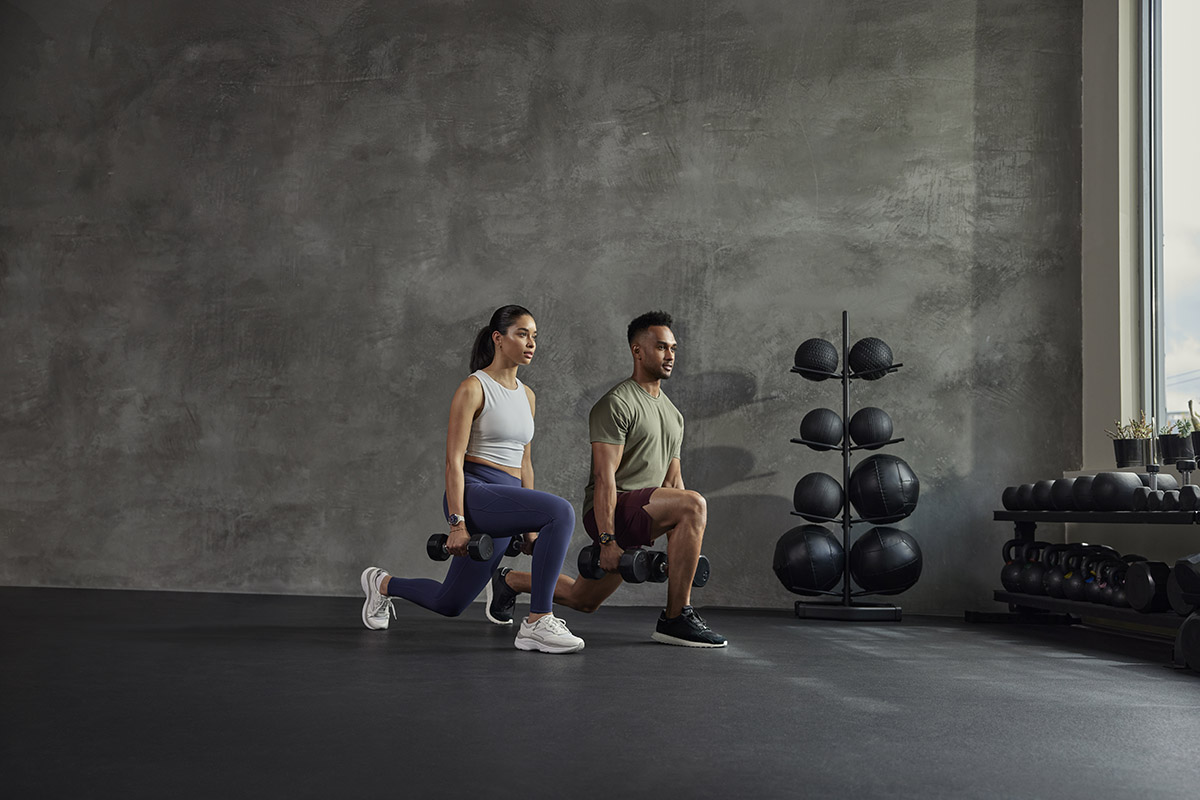
Lunges are Indispensable in the Lower Limb Training for Runners
As a runner, when it comes to the free weight of the lower limbs, you can’t ignore the lunge, a movement that has various forms and significant training effects.
The lunge is almost an indispensable training exercise for the lower limb. The main reason is that it can train the balance and proprioception of the body. It can also adjust the angle and mobility of the torso and joints (hip, ankle) and it is a great training for the muscles. This exercise can be used during the warm up or the main training schedule, and it also helps with running performance.
This article mainly discusses how to make the most effect and change out of lunges.
Let’s first review what a lunge is. From the posture, lunges and squats seem to be somewhat related. For example, we can try to do a standard squat, and then move one leg forward and extend one leg backward to form a basic lunge.
Generally speaking, there are two standard positions for lunges, which are namely lunge with an upright torso and lunge with a slight forward lean of the torso. There are some differences in the effectiveness and purposes of training between the two.
Lunge with an Upright Torso
In an upright lunge, our torso must remain upright and maintain a 90-degree angle to the ground. At that moment, the weight of the upper body will be directly on the hips.

Source
From a biomechanical point of view, the joints farthest from the load will bear the greatest pressure, so the knee will bear the greatest torque. In order to maintain the posture, the muscles for the extension of the knee will take on greater responsibility, which is to say that our quadriceps is the main muscle group exerting power. If the movement is done incorrectly (for example, excessive internal or external rotation of the knee), then, of course, the risk of injury will also be greater.
Methods of weight-bearing lunges are split into both hands carrying dumbbells or using barbells. The former can train our balance, core muscles, and proprioception, while the latter, with the barbell on our back, makes it easier for us to train with heavier weights. Both have their advantages.

Lunge with a Slight Forward Lean of the Torso
If we perform the lunge with a certain angle of the torso tilted forward, the weight of the upper body will be evenly distributed on the hip joints, knee, and ankle. The main load will fall between the hip and knee joints, so the muscles that move the joints will be trained, which is to say that our gluteal muscles and quadriceps will both participate in this training.
Strengthen the Use of Gluteal Muscles?
After reading the brief introduction above, we notice that the tilted angle of the torso can slightly change the power chain of the human body: the greater the forward tilt angle, the greater the participation of the gluteal muscles, while the quadriceps are the opposite, so we can adjust the forward leaning angle of the torso to increase the stimulation of the gluteal muscles.
When performing lunges, we can apply eccentric weight-bearing training to the gluteus maximus on the sagittal plane and the rotational plane by, respectively, leaning forward (bending body at hips) and rotating the torso forward (internal hip rotation of the front leg) to increase the need to use the gluteus maximus. For example, when we perform a lunge with our left leg in front, our right shoulder rotates in the direction of our left knee. In order to engage the gluteal muscles as much as possible, keep the heel of the front leg on the ground as much as possible when carrying out the process and keep the body’s center of gravity evenly distributed over the front foot.
Multiplane Lunge Training
Besides front and back, multi-directional lunge is also a good training method. When the direction of force is different, the body will have specific reactions. For example, when we perform side lunges, we can strengthen our body’s adaptation in the lateral direction. Therefore, in addition to traditional lunges, I also recommend mixed training with multiple planes and multiple angles.
You can try using the following simple tips:
1. Keep your feet shoulder-width apart, step forward with your hips in a neutral position;
2. First try to do a forward lunge to ensure that the knee does not bend inwards or outwards. Use the heel of the front leg to exert force on the ground without shifting the overall center of gravity. Rely on the back leg to maintain balance;
3. Next, try to raise and keep your hands parallel to the ground and rotate 90 degrees horizontally. If the center of gravity is unstable in the beginning, the knee of your back leg can touch the ground. When you become familiar with the exercise, you can try to keep your knees from touching the ground. For a more advanced exercise, you can hold light-weight dumbbells in your hands to increase the difficulty.

Lastly, when doing lunges, be careful not to take too big of a stride, especially for those with tight hip flexors. If this type of person takes too big of a lunge step, there will be increased pressure on their lower back. In addition, they must also pay attention and make sure that their hips, knee, and ankle form a straight line, or else, it can easily cause torsion and lateral pressure, which will easily cause injury to the knee joints and ligaments.




